July 21, 2006
Sad knights who say nü
Prof. David Myers was kind enough to write back quickly, and as I suspected, the story about umlauts making Germans unhappy is another Glenn Wilson media moment. That is, a fabrication by a reporter looking to sculpt a good story out of some scraps of science and a whole pile of journalistic manure.
His note:
Hoo boy, Mark.
This story, which I see is still recycling through the media, is perhaps the most bizarre incident of my career. The journalist who originally wrote it did interview me. But I never reported doing any such research (and haven't). (The finding attributed to me was then republished by various people and media worldwide, leading to dozens of letters. . . . some from angry Germans!)
Here, from my Psychology 8th edition, is the closest thing to what's reported . . . the second bulleted point regarding the Zajonc study (but even that study doesn't contend that Germans are unhappy people because of their language).
Not for the first time, the BBC should be ashamed of itself. Not for the first time, there's no evidence of any such reaction. Perhaps if the expressions appropriate for shame were electrically imposed on their faces, a bit of the corresponding emotion would leak up into their limbic systems?
I believe that Prof. Myers' reference to "Zajonc & others" is Zajonc, Murphy and Inglehart, "Feeling and Facial Efference: Implications of the Vascular Theory of Emotion", Psychological Review, 96(3) 394:416, 1989. This turns out to be a pretty interesting paper. It seems that umlauts make you hot-headed -- literally. From the abstract:
The vascular theory of emotional efference (VTEE) holds that facial muscular movement, by its action on the cavernous sinus, may restrict venous flow and thereby influence cooling of the arterial blood supply to the brain. Subjective reactions resulting from facial action (phonetic utterance), resembling but unrelated to emotional efference, were found to differ in hedonic quality and to produce correlated changes in forehead temperature. Direct tests that introduced air into the nasal cavity revealed that cooled air was pleasurable, whereas warm air was aversive. It is conjectured that variations in cerebral temperature might influence the release and blocking of emotion-linked neurotransmitters—a consequence that would explain, in part, why some experiences are felt subjectively as pleasant and others as unpleasant.
The first of the Zajonc et al. experiments went like this:
Subjects. A total of 26 native German speakers, who were either exchange students, visiting scholars, or University of Michigan professors, and who spoke German daily, were solicited to participate in the following study. They ranged in age from 20 to 65 years. The ostensive purpose of this and of the following four studies was that they dealt with language acquisition.
Materials. Four short (approximately 200 words) stories were written in German for the purposes of Study 1. Of the four stories, two contained a high frequency of the vowel ü, whereas the remaining two contained no words at all with the vowel ü. Two sets of stories were compiled, each consisting of one ü story and one no-ü story. One set of stories involved young boys, Peter and Jurgen (in the no-ü story and in the ü story, respectively), who wished for their birthdays either dogs and cats (Hunde und Katzen) or foxes and hens (Füchse und Hühner). The second set of stories were written in the style of newspaper articles, depicting Peter Meier, who excelled in shot put (Kugelstosser), and Günter Müller, a promising young hurdler (Hürdenlaüfer). Within each set, every attempt was made to match the ü and no-ü stories for emotional tone and semantic content.
Procedure. Each subject was asked to read aloud one set of two stories; one half of the subjects read an ii story first followed by a no-ü story, and one half read the stories in the opposite order. To obtain an indication of cerebral temperature changes, thermographic images of subjects' faces were collected using an AGA infrared Thermographic 782M system. The argon-cooled thermographic camera takes an infrared television image that generates isotherms of surface temperature variations. Depending on the range of temperature variations investigated, different absolute degrees of resolution can be obtained. For our purposes, a range of variation was selected that generated a resolution of 0.5 "C, which was found adequate at the aggregate level. After a 10-min habituation period that stabilized facial temperature, baseline images were collected from each subject prior to reading each story. Subsequent images were taken immediately after subjects read each of the four paragraphs of a story.
After reading both stories aloud, subjects completed a questionnaire probing both their affective reactions to the stories and their recall of the information conveyed. The affect questions asked the subject to make pairwise comparisons of the two stories regarding the suitability of each story for children, their relative resemblance to a fable, the quality of the German prose, the formality of the language, which story was more interesting, and most important, which of the two was more pleasant and which the subject liked better. Free recall questions for the animal stories asked for the names of the protagonists, the color of a truck that brought the animals, which birthday was being celebrated, and what animals the children wished for and received. Similar items were asked in the sports stories.
The results? The ü-ful stories caused readers' facial temperatures to rise, while the ü-less stories didn't:
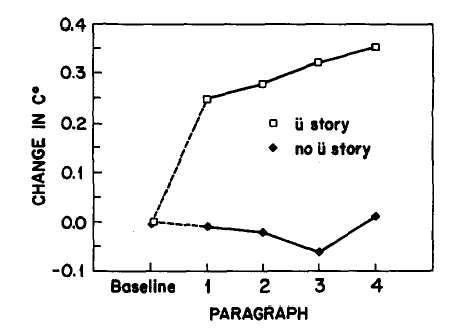
Pronouncing ü vs. o in isolation had similar results, in their Experiment 3:
Subjects. A total of 20 native German speakers and 20 Americans served as subjects. ...
Procedure. Both German and American subjects repeated aloud after a tape-recorded voice the vowel sounds ü and o 20 times each, at 3-s intervals. In the course of uttering the vowel phonemes, thermographic readings were taken before the vowel session (baseline) and after the 5th, 10th, 15th and 20th repetition of each vowel sound. Finally, subjects rated the two sounds on 7-point scales according to how pleasant, familiar, and difficult they were to produce, and how much they liked each sound.
Results? "The phoneme o had no apparent effect on forehead temperature, producing a change of only +0.02 °C. In response to the
phoneme ü , however, there was a rise of+0.14 °C, F(1, 35) = 4.40, p < .04." And both Germans and Americans reported liking o somewhat better than ü:
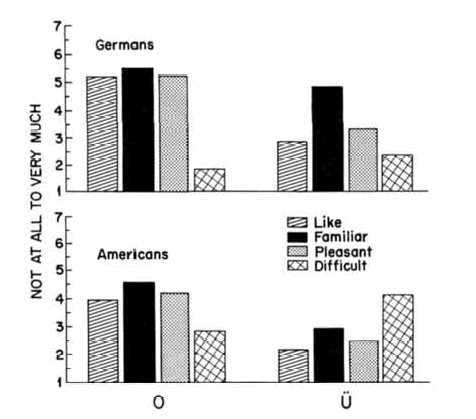
Now we get to the good stuff, Experiment 4:
Subjects. A total of 26 male introductory psychology students at the University of Michigan participated in this study in partial fulfillment of a course requirement.
Procedure. Subjects arrived separately and were informed that the experimenter would be with them momentarily. A 10-min habituation period that stabilized facial temperature was necessary to ensure that subjects, who had been exposed to varying weather conditions, returned to a normal range of temperature. After this time elapsed, subjects were told that they would be involved in a study of language acquisition and were given a copy of the following instructions:The first segment of this experiment requires that you repeat seven vowel sounds aloud twenty times each following a tape-recorded voice. Please try to repeat each sound as accurately as possible even though several vowels may sound unfamiliar. Because you will be photographed periodically throughout these repetitions, it is extremely important that you do not move your head. Following each series of twenty repetitions you will be asked several questions about that particular vowel sound. Do you have any questions?
Subjects then repeated aloud after a tape-recorded voice the first vowel sound 20 times, at 3-s intervals. Thermographic readings were collected, as previously, prior to the vowel session (baseline) and following the 5th, 10th, 15th and 20th repetitions. After the 20 repetitions, subjects were asked to rate the sounds on 7-point scales according to how pleasant, familiar, and difficult it was to produce, as well as how much they liked the sound and whether it put them in a good or bad mood. This procedure was repeated for the remaining six vowel sounds. To control for possible order effects, one half of the subjects were presented with the seven vowel sounds in one order (i, e, o, a, ü, ah, u) and one half in another order (i, ü, o, a, e, ah, u). Note that only the phonemes that are of focal interest, namely e and ü, change places to control for position effects. The positions of the other phonemes remained constant.
It's not made clear in the paper what these "vowel sounds" really were. The fact that "a" and "ah" are treated as separate "vowel sounds" suggests that maybe "a" means the pronunciation of the letter A, rather than IPA [a]. This would imply that the "vowel sound" written as "e" is IPA [i]. Anyhow, here's the effect of different vowels on facial temperature:
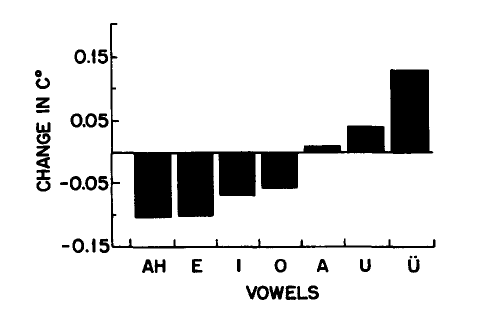
And here's a graph showing how much the speakers liked the different vowels:
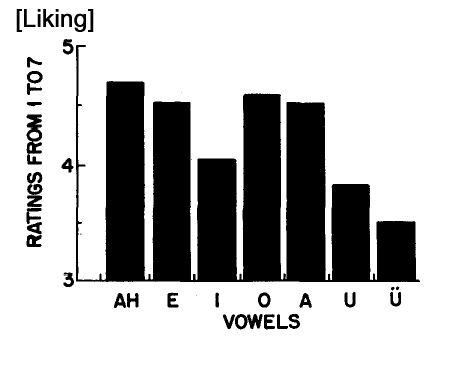
And finally, the pay-off -- how the speakers said the vowels affected their mood:
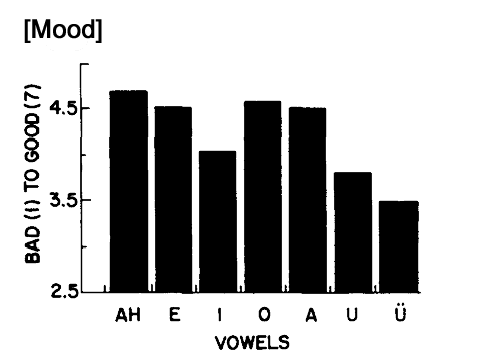
This is pretty persuasive. At least, it persuades me that if you ask undergraduates how good repeating [i] 20 times makes them feel, they respond on average with a higher mood rating than if you ask them how good repeating [y] 20 times makes them feel. It worries me a bit that the evaluation is so meta -- the subjects are asked explicitly "how much they liked the sound and whether it put them in a good or bad mood", which seems quite likely to produce different results from simply checking their mood. The explicit causal tie to the (changing) vowel sounds will surely amplify the span of self-reported moods -- I tend to doubt that as a subject in this experiment, I would really become especially mournful or especially ecstatic. Rather, I imagine that I would feel mildly bored throughout, but would attempt to cooperate with the experimenter (in pursuit of my Psych 101 grade) by guessing how the various "vowel sounds" ought to be associated with moods.
Or then again, maybe I'd just be reading my mood off my facial temperature. If so, you might think that a splash of cool water might be more effective than saying [i] twenty times. And indeed, though Zajonc et al. didn't try cold water, they did test the results of warm and cold air, in an experiment that pretended to be about smells. The results:
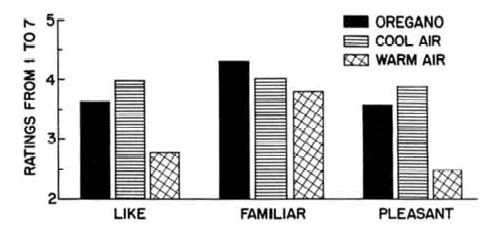
So when the BBC posed the question "Ex-Chancellor Kohl: Glum over political woes or vowel sounds?", maybe they should have added "or inadequate air conditioning?" We've had rolling chilled-water cut-offs at Penn recently, to save energy, and no one has thought to suggest to overheated office workers that they just say "ee". (And maybe when the heat fails in the winter, as it sometimes does, we should try the umlaut option?) Somehow I doubt that either vowel will help much, though I should be careful about expressing an opinion without a scientific test.
[This post's title courtesy of Jonathan Lundell, who wrote (with respect to the quote from Izard in my earlier post):
I don't think this is as far from James's idea as Izard makes it out to be ("Although this hypothesis has been attributed to Darwin, James, Tomkins, Gellhorn, and Izard, it is clearly distinct from their ideas..."). James in PP concocts characteristically cartoonish examples, but I rather think he'd have agreed that the physical mediation of emotion needn't be as overt as striking, running or crying. (In any event, let's please have more posts that find a reason to quote both James and Wittgenstein. Post-PP and post-TLP preferred, though.)
]
Posted by Mark Liberman at July 21, 2006 08:10 PM